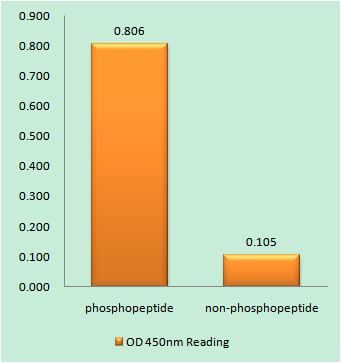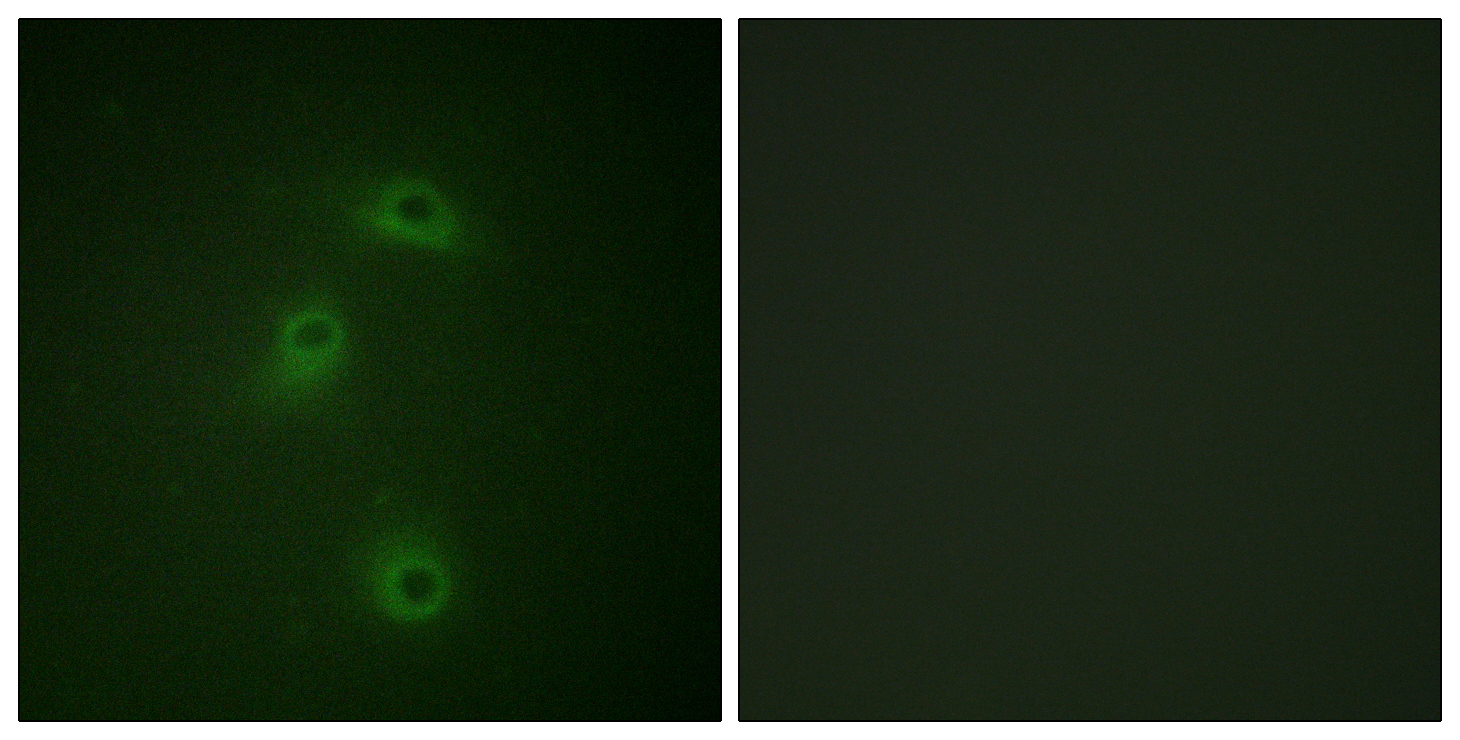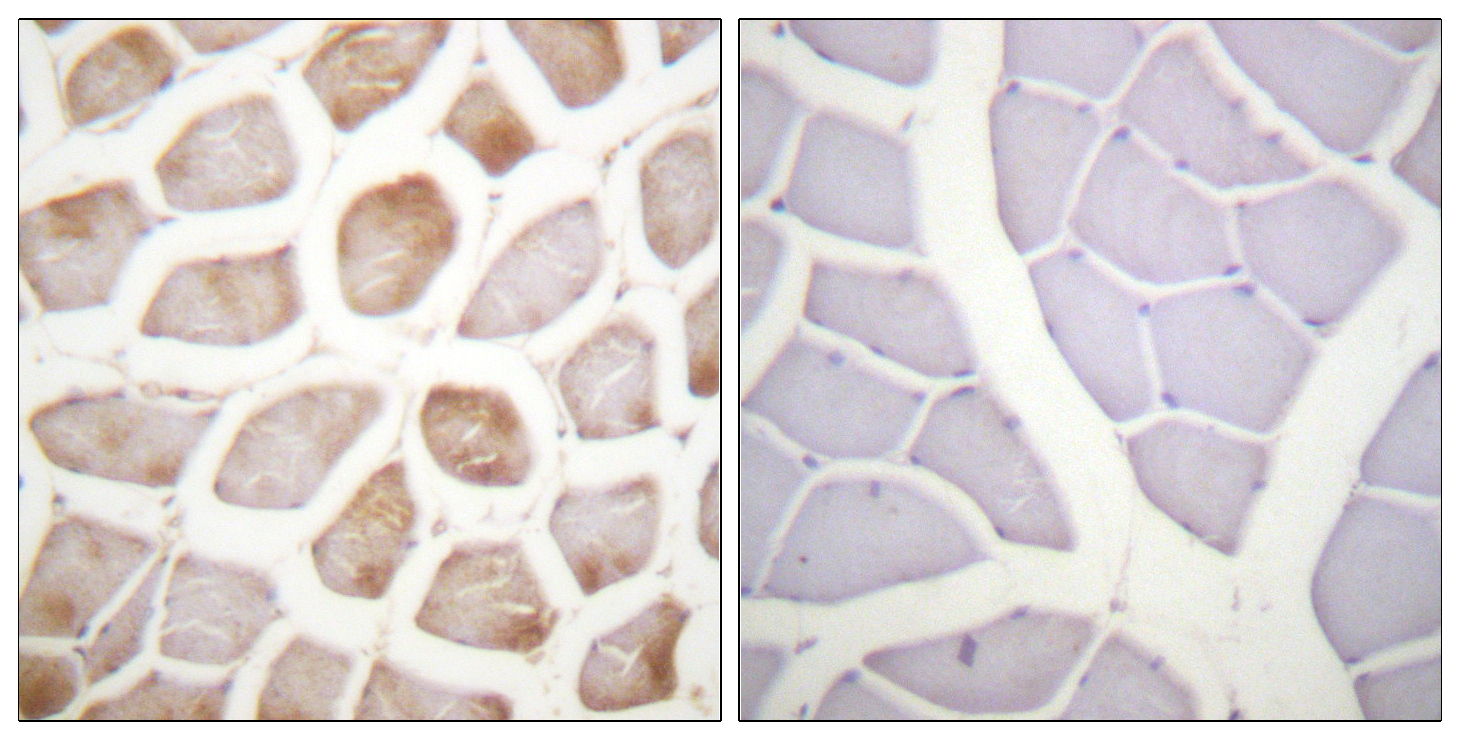DAPK2 (phospho Ser318) Polyclonal Antibody
- Catalog No.:YP1142
- Applications:IHC;IF;ELISA
- Reactivity:Human;Mouse;Rat
- Target:
- DAPK2
- Fields:
- >>Autophagy - animal;>>Pathways in cancer;>>Bladder cancer
- Gene Name:
- DAPK2
- Protein Name:
- Death-associated protein kinase 2
- Human Gene Id:
- 23604
- Human Swiss Prot No:
- Q9UIK4
- Mouse Gene Id:
- 13143
- Mouse Swiss Prot No:
- Q8VDF3
- Immunogen:
- The antiserum was produced against synthesized peptide derived from human DAPK2 around the phosphorylation site of Ser318. AA range:284-333
- Specificity:
- Phospho-DAPK2 (S318) Polyclonal Antibody detects endogenous levels of DAPK2 protein only when phosphorylated at S318.
- Formulation:
- Liquid in PBS containing 50% glycerol, 0.5% BSA and 0.02% sodium azide.
- Source:
- Polyclonal, Rabbit,IgG
- Dilution:
- IHC 1:100 - 1:300. IF 1:200 - 1:1000. ELISA: 1:5000. Not yet tested in other applications.
- Purification:
- The antibody was affinity-purified from rabbit antiserum by affinity-chromatography using epitope-specific immunogen.
- Concentration:
- 1 mg/ml
- Storage Stability:
- -15°C to -25°C/1 year(Do not lower than -25°C)
- Other Name:
- DAPK2;Death-associated protein kinase 2;DAP kinase 2;DAP-kinase-related protein 1;DRP-1
- Molecular Weight(Da):
- 43kD
- Background:
- This gene encodes a protein that belongs to the serine/threonine protein kinase family. This protein contains a N-terminal protein kinase domain followed by a conserved calmodulin-binding domain with significant similarity to that of death-associated protein kinase 1 (DAPK1), a positive regulator of programmed cell death. Overexpression of this gene was shown to induce cell apoptosis. It uses multiple polyadenylation sites. [provided by RefSeq, Jul 2008],
- Function:
- catalytic activity:ATP + a protein = ADP + a phosphoprotein.,cofactor:Magnesium.,enzyme regulation:Negatively regulated by autophosphorylation on Ser-318.,function:Calcium/calmodulin-dependent serine/threonine kinase which acts as a positive regulator of apoptosis.,similarity:Belongs to the protein kinase superfamily. CAMK Ser/Thr protein kinase family. DAP kinase subfamily.,similarity:Contains 1 protein kinase domain.,subunit:Homodimer. Homodimerization is required for apoptotic function and is inhibited by autophosphorylation at Ser-318.,tissue specificity:Ubiquitously expressed in all tissue types examined. High levels in heart, lung and skeletal muscle.,
- Subcellular Location:
- Cytoplasm. Cytoplasmic vesicle, autophagosome lumen.
- Expression:
- Expressed in neutrophils and eosinophils (PubMed:24163421). Isoform 2 is expressed in embryonic stem cells (at protein level). Isoform 1 is ubiquitously expressed in all tissue types examined with high levels in heart, lung and skeletal muscle.
- June 19-2018
- WESTERN IMMUNOBLOTTING PROTOCOL
- June 19-2018
- IMMUNOHISTOCHEMISTRY-PARAFFIN PROTOCOL
- June 19-2018
- IMMUNOFLUORESCENCE PROTOCOL
- September 08-2020
- FLOW-CYTOMEYRT-PROTOCOL
- May 20-2022
- Cell-Based ELISA│解您多样本WB检测之困扰
- July 13-2018
- CELL-BASED-ELISA-PROTOCOL-FOR-ACETYL-PROTEIN
- July 13-2018
- CELL-BASED-ELISA-PROTOCOL-FOR-PHOSPHO-PROTEIN
- July 13-2018
- Antibody-FAQs
- Products Images

- Enzyme-Linked Immunosorbent Assay (Phospho-ELISA) for Immunogen Phosphopeptide (Phospho-left) and Non-Phosphopeptide (Phospho-right), using DAPK2 (Phospho-Ser318) Antibody

- Immunofluorescence analysis of COS7 cells, using DAPK2 (Phospho-Ser318) Antibody. The picture on the right is blocked with the phospho peptide.

- Immunohistochemistry analysis of paraffin-embedded human skeletal muscle, using DAPK2 (Phospho-Ser318) Antibody. The picture on the right is blocked with the phospho peptide.



